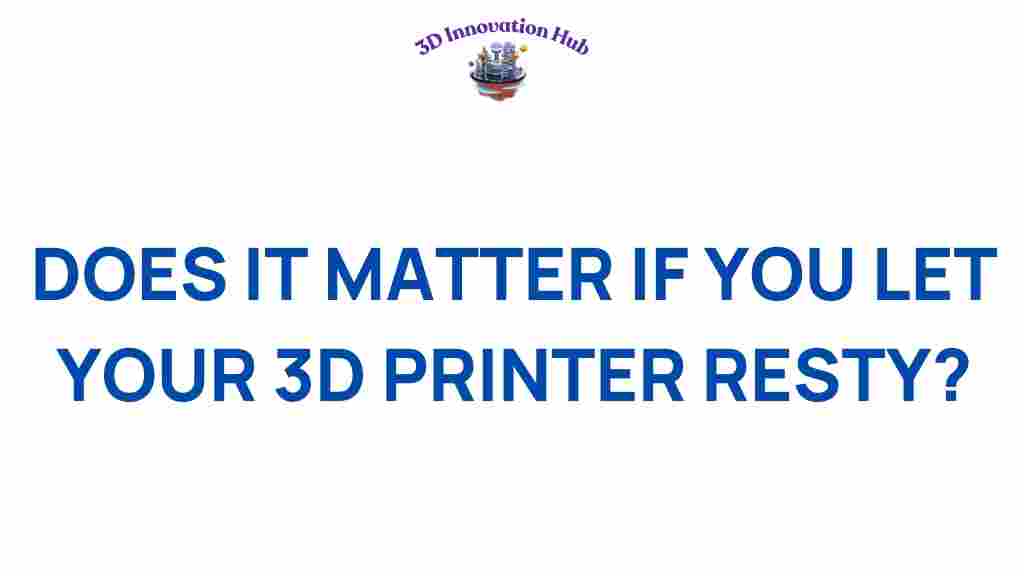The Hidden Impact of 3D Printer Downtime: Does It Really Matter?
In the world of additive manufacturing, 3D printers have revolutionized the way we design and produce objects, offering unparalleled efficiency and innovation. However, like any technology, 3D printers are not immune to downtime. Understanding the impact of downtime on performance and print quality is crucial for manufacturers and hobbyists alike. This article explores the hidden consequences of 3D printer downtime, examines best practices for maintenance, and offers insights into enhancing the overall efficiency of your 3D printing operation.
Understanding 3D Printer Downtime
Downtime refers to the period when a 3D printer is not operational due to various factors, including maintenance, repairs, or unexpected failures. This can lead to significant disruptions in production schedules and impact the overall efficiency of your workflow. To appreciate the full impact of downtime, consider the following:
- Lost Productivity: Every hour a 3D printer is down translates to lost productivity, which can affect project timelines and client satisfaction.
- Increased Costs: Downtime can result in additional costs associated with labor, materials, and missed deadlines.
- Decreased Quality: Frequent disruptions can lead to rushed jobs, negatively impacting print quality.
- Resource Waste: Unused materials during downtime can lead to waste, further increasing operational costs.
The Importance of Maintenance
Regular maintenance is essential to minimize downtime and ensure optimal performance of your 3D printer. Here are some key maintenance practices:
- Routine Cleaning: Regularly clean the print bed, nozzles, and other components to prevent clogs and ensure smooth operation.
- Calibration: Periodically calibrate your printer to maintain accurate print dimensions and quality.
- Software Updates: Keep your printer’s firmware and slicing software up to date to benefit from the latest features and bug fixes.
- Part Replacement: Monitor wear and tear on components such as belts, bearings, and nozzles, replacing them as needed.
Impact on Print Quality
Downtime can have a direct effect on print quality. When a printer is not properly maintained or experiences frequent failures, the quality of the prints can suffer. Here are some key points to consider:
- Inconsistent Results: Frequent downtime can lead to inconsistent print quality, resulting in variations in layer adhesion and surface finish.
- Failed Prints: Downtime often leads to an increase in failed prints, which can waste time and materials.
- Material Degradation: Leaving materials unused during extended downtime can lead to degradation, affecting print quality when you resume printing.
Step-by-Step Process to Minimize Downtime
To effectively reduce downtime and enhance the efficiency of your 3D printing operation, follow these best practices:
1. Develop a Maintenance Schedule
Implement a regular maintenance schedule that includes daily, weekly, and monthly tasks. This can help you stay ahead of potential issues before they lead to significant downtime.
2. Train Your Team
Ensure that everyone involved in operating the 3D printer is properly trained in both operation and maintenance. This can reduce the likelihood of user error, which is a common cause of downtime.
3. Monitor Performance Metrics
Keep track of performance metrics such as print success rates, downtime incidents, and maintenance logs. This data can help you identify patterns and areas that need improvement.
4. Invest in Quality Technology
Choose high-quality, reliable 3D printers and components. Investing in better technology can lead to fewer breakdowns and less downtime.
5. Utilize Predictive Maintenance
Consider using predictive maintenance technologies that can analyze data from your printer to forecast potential failures before they occur. This proactive approach can significantly reduce downtime.
Troubleshooting Tips for Common Downtime Issues
Even with the best maintenance practices, downtime can still occur. Here are some troubleshooting tips for common issues:
- Printer Won’t Start: Check the power supply and connections. Ensure that the printer’s firmware is up to date.
- Print Failures: Investigate the material settings and ensure that the nozzle is clear. Re-calibrate the printer if necessary.
- Inconsistent Extrusion: Clean the nozzle and check for clogs. Ensure that the filament is properly loaded and that the drive gear is functioning correctly.
- Layer Adhesion Problems: Adjust print settings such as temperature, speed, and layer height to improve adhesion.
Conclusion: The Value of Minimizing Downtime
In conclusion, the hidden impact of 3D printer downtime can be significant, affecting everything from performance to print quality. By implementing effective maintenance practices and adopting a proactive approach to troubleshooting, you can greatly enhance the efficiency of your 3D printing operations. Remember that the goal is not just to reduce downtime but to foster a culture of innovation and quality in your 3D printing endeavors. Explore more about best practices in 3D printing maintenance and make the most out of your technology.
By prioritizing maintenance and staying informed about the latest advancements in 3D printing technology, you can ensure that your operations run smoothly and effectively. The future of 3D printing is bright, and with the right approach, you can be at the forefront of this exciting field of innovation.
For further reading, visit this resource on 3D printing technologies and trends.
This article is in the category and created by 3D Innovation Hub Team
